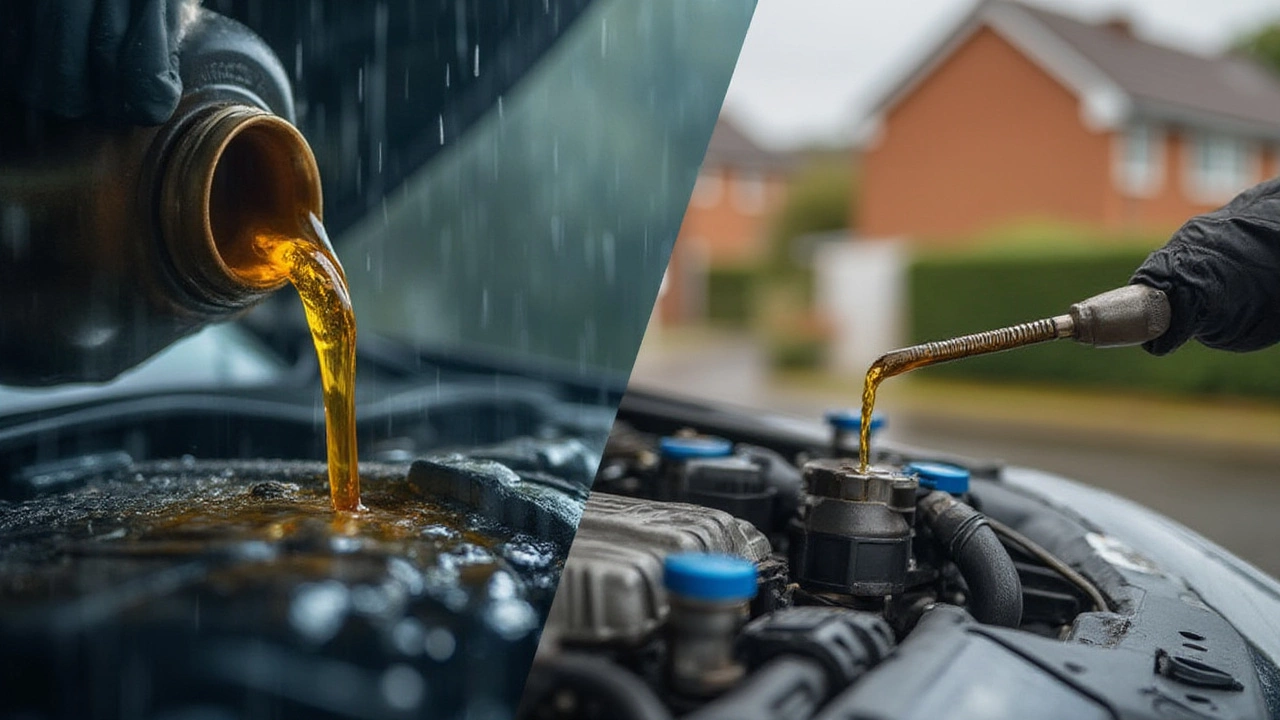Ever found yourself squinting at a bottle in the auto aisle, asking if engine oil and motor oil are actually different? It's one of those debates that creeps up in garages and online forums, but most people walk away even more confused. The funny thing? There’s a good chance that what you know—or think you know—about these oils isn’t the whole story. Some mechanics might roll their eyes and say it’s just marketing, while others will argue about long-lost technical details. So let’s unpack it. The question stumps everyone from first-time car buyers to gearheads with oily hands.
Where Did Engine Oil and Motor Oil Come From?
If you hop back a hundred years or so, cars and their engines looked nothing like today’s rides. Early engines burned just about anything oily. Before modern refining, motor oil was dirty stuff—full of impurities, parrafin, and unpredictable performance. Back then, people called it motor oil because it was for any motor, not just those in cars. “Motor” was the hip word for what we now just call “engines.” Fast forward, car engines became more powerful, hotter, and fussier about what they drank. Oil companies started tinkering with formulas, adding detergents after World War II—imagine the relief of not having to scrape sludge off every part during an oil change!
Nowadays, the oil you pour into your engine is the result of decades of chemistry experiments and trial by fire. Lubricants are loved by your car’s pistons, but also do double duty: cooling, cleaning, protecting, and even helping with emissions. Most companies now stamp bottles with both "engine oil" and "motor oil" labels, knowing shoppers still use both names. Over 60% of American car owners use these terms interchangeably. When official bodies like the American Petroleum Institute or oil giants like Shell and Mobil talk about recommendations, they rarely draw a technical line between “engine” and “motor” oil. Marketing probably has more to do with these names sticking around than any science does.
Here’s a fun fact: “Motor oil” was actually the more common label in the U.S. until the late 1970s, when “engine oil” gained popularity alongside the rise of smaller, turbocharged, and more complicated engines. Car manuals started switching the terminology, probably because “engine” sounds more, well, modern. In the U.K., “engine oil” has always been more common, while classic American car shows are still full of “motor oil” banners.
The Chemistry: What’s Actually in the Bottle?
Let’s get into the gory details—with no chemistry degree needed. Engine oil (or motor oil, depending on what it says) is almost always made up of two things: base oil and an additive package. The base oil can be mineral (from crude oil), synthetic (chemically engineered), or some blend of both. Range through the aisle and you’ll see “SAE 5W-30” or “10W-40.” Those cryptic numbers are viscosity ratings—a huge deal for how your car starts and runs in different temperatures. The difference in those numbers—think how honey flows in your spoon versus water—shows how the oil will move when cold or hot and how well it will stick to your engine’s moving bits. Wild fact: a good modern oil doesn’t just make things slippery. It can double the life of certain parts compared to what your granddad used.
Additives are the secret sauce—detergents, anti-wear agents, dispersants, and antioxidants. They’re like the vitamins in your oil, fighting abuse from inside the engine. Cheap oil may skip on these, and your car could suffer for it. Have you seen how modern engines stay spotless inside for 100,000 miles? That’s these additives at work. The crazy part: two bottles labeled "engine oil" and "motor oil" from the same manufacturer, with the same viscosity grade, are pretty much identical in content.
Take a look at this data table showing common differences and key specs:
| Label on Bottle | Main Usage | Base Oil Type | Additive Type | SAE Viscosity Grades Available | Typical Shelf Life |
|---|---|---|---|---|---|
| Engine Oil | Automotive Engines | Mineral/Synthetic/Blend | Detergent, Anti-wear, Dispersant, etc. | 0W-16 to 20W-50 | 5 Years |
| Motor Oil | Engines (Cars, Small Motors) | Mineral/Synthetic/Blend | Detergent, Anti-wear, Dispersant, etc. | 0W-16 to 20W-50 | 5 Years |
If you’re expecting an aha-moment difference, this is it: there’s no chemical or performance divide based on the label alone. The only real separation is in marketing or tradition by region or manufacturer.

Marketing, Myths, and Modern Day Confusion
So why do people still argue about the difference, if there isn’t any? Blame it on a mix of clever advertising and car culture. Walk into any parts store and you’ll find rows of bottles boasting about “formulas for modern engines” or “classic motor oil protection.” Companies love to tap into nostalgia or high-tech vibes—even for products that are basically the same thing. Sometimes, niche products (like oils specifically for old classic cars or motorcycles) carry the “motor oil” badge by choice, while “engine oil” is pushed as the all-rounder for modern vehicles. But even then, the specs usually match up with modern engine oil requirements.
Magazines and online influencers often fuel the rivalry, churning out articles that compare “engine oil vs motor oil” as if one’s hiding secret powers. The real myth-busting moment: any oil that meets your car’s required specs (like "API SN Plus," "ILSAC GF-6," or specific manufacturer approval codes), is doing exactly what it should. The words “engine” or “motor” alone don’t tell you if it’s right for your car—the oil’s weight, base, and approval ratings do all the heavy lifting. The American Petroleum Institute (API) and Society of Automotive Engineers (SAE) are the real deal-breakers here, not what’s on the front of the label.
There are some urban legends floating around, like “Motor oil is for motorcycles and small equipment, engine oil is for cars.” Not true. Fact: most motorcycles use separate, specialized oils, but even their bottles will switch between the two phrases. Pick up your lawnmower manual and chances are it calls for "engine oil"—same as your car. As cars become more advanced, picky about emissions, fuel economy, and wear, oil companies stay busy tweaking formulas, but the big-name brands haven't drawn a line between "engine" and "motor" oil in their chemical makeup.
If you’re truly obsessed with keeping your car in top shape, watch for labels and numbers that matter—not whether motor or engine comes first. Use your car’s manual as your Bible here. Ignore the choir arguing over the name; focus on the oil grade and certification seals, especially for newer cars with strict requirements. Fun side note: synthetic oils have jumped from niche to almost standard, since some engines (especially German models or turbocharged cars) demand their extra performance, and every major brand markets synthetic products as both “motor” or “engine” oil. It’s all about the specs, not the name.
Practical Tips for Choosing the Right Oil
When it's time for your next oil change, forget about fretting over the “engine” or “motor” debate. Instead, keep these pointers in mind to help you cut through the noise:
- Read your owner’s manual. It spells out the recommended viscosity and certification for your specific engine. Ignore advice from friends and internet strangers who don’t drive the same car.
- Look for the certification marks: API (American Petroleum Institute), ACEA (European cars), or manufacturer approvals (like Mercedes-Benz 229.5 or GM dexos). These are your guarantee that the oil meets tough standards.
- Choose the right viscosity for the climate you live in. That “W” in the oil number is about how well it flows when cold—crucial if you live somewhere with frigid winters or blazing summers.
- Don’t cheap out on oil for modern engines. High-performance engines, direct fuel injection, and turbochargers need top-tier oil to prevent issues like low-speed pre-ignition or carbon buildup. Saving a few bucks often costs big later.
- Check if your oil needs to be synthetic. Modern cars, especially European and turbocharged models, often require full synthetic oil for maximum protection and efficiency.
- Avoid noname brands unless there’s clear proof they meet relevant standards. Well-known brands maintain strict quality, while bargain oils sometimes skimp on key additives.
- Change your oil at the intervals listed in your manual. Don’t buy the "3000-mile myth"—newer oils and engines usually last a lot longer between changes, sometimes up to 10,000 miles or more.
- Don’t mix oil grades unless you’re stuck in a pinch and planning to drain it soon. If you accidentally mix synthetic and conventional oil once, you won’t blow up your engine—but it’s not ideal for long-term care.
- Watch for leaks and consume less oil by using the right viscosity and checking levels between changes. Low oil grime is a sign your additives are doing their job well.
- Store oil in a cool, dry place. Sealed bottles last up to five years on a shelf, but opened bottles should be used within six months for best results.
- Recycling matters. Take used oil to collection centers—two gallons of used oil can generate enough electricity to power a home for a day. Dumping it in the yard pollutes a million gallons of fresh water.
People love to “upgrade” their oil just in case, but if your car’s never needed a premium synthetic blend, old habits die hard. The *engine oil* in both name and function protects engines whether you're driving a 1990s pickup or a 2025 turbo Mustang. Labels will change and advertising won’t stop twisting words. But if you understand the specs, you'll never let a name confuse you again.





